Geo-blocking and Geo-fencing are two closely related concepts in the context of Content Delivery Networks (CDNs). Both involve restricting access to content based on the geographic location of the user.

Geo-blocking is the practice of preventing users from accessing certain content based on their IP address or other location data. This is typically done for legal reasons, such as to comply with copyright laws or to protect sensitive information. For example, a streaming service may geo-block content in certain countries due to licensing restrictions.
Geo-fencing is a more specific form of geo-blocking that creates a virtual boundary around a specific geographic area. Users within the boundary are allowed access to the content, while users outside the boundary are blocked. This is often used for location-based marketing or to restrict access to events or experiences to a specific region. For example, a retailer may use geo-fencing to offer exclusive promotions to customers in a particular city.

CDNs play a key role in both geo-blocking and geo-fencing by providing the infrastructure to deliver content to users based on their location. CDNs have servers located in multiple locations around the world, which allows them to quickly and efficiently deliver content to users in different regions.
Benefits of Geo-blocking and Geo-fencing
- Compliance with regulations: Geo-blocking can help businesses comply with copyright laws and other legal requirements.
- Protection of sensitive information: Geo-fencing can be used to protect sensitive information, such as financial data or trade secrets, from being accessed by unauthorized users.
- Targeted marketing: Geo-fencing allows businesses to target their marketing campaigns to specific geographic areas.
- Enhanced user experience: Geo-blocking and geo-fencing can improve the user experience by delivering content that is relevant to their location.
Challenges of Geo-blocking and Geo-fencing
- User privacy concerns: Geo-blocking and geo-fencing can raise privacy concerns, as they involve collecting and using location data.
- Evasion techniques: Users can use various techniques to evade geo-blocking and geo-fencing, such as using VPNs or proxy servers.
- Cost and complexity: Implementing and maintaining geo-blocking and geo-fencing systems can be costly and complex.
Overall, geo-blocking and geo-fencing are valuable tools for businesses that need to restrict access to content based on location. However, it is important to consider the benefits and challenges of these technologies before implementing them.## Understanding Geo-blocking And Geo-fencing In Cdn Context
Executive Summary
Geo-blocking and geo-fencing are two essential concepts in the context of content delivery networks (CDNs). Geo-blocking restricts access to content based on geographical location, while geo-fencing creates a virtual boundary around a specific area and delivers content within that boundary. This article provides a comprehensive understanding of these concepts, their applications, benefits, and considerations.
Introduction
In today’s digital age, geographical boundaries can hinder access to online content. Geo-blocking and geo-fencing offer solutions to address these challenges, enabling businesses to deliver content to specific regions and enhance user experience.
FAQs
Q: What is the difference between geo-blocking and geo-fencing?
A: Geo-blocking restricts access to content based on geographical location, while geo-fencing establishes a virtual boundary and delivers content within that boundary.
Q: Why are geo-blocking and geo-fencing used?
A: Geo-blocking and geo-fencing are used to enforce licensing agreements, comply with regulations, target specific markets, and enhance user experience.
Q: Are there any limitations to geo-blocking and geo-fencing?
A: Geo-blocking and geo-fencing can be circumvented using proxy servers, VPNs, or other technologies. Additionally, they may be illegal in certain jurisdictions.
Subtopics
Geo-blocking
Geo-blocking restricts access to content based on the user’s geographical location. It involves identifying the user’s IP address and comparing it to a database of restricted locations.
- IP Address Identification: Determining the user’s location based on their IP address.
- Database Maintenance: Maintaining a comprehensive database of restricted locations.
- Content Access Control: Blocking access to content for users in restricted locations.
- Licensing Compliance: Ensuring compliance with licensing agreements that limit content distribution to certain regions.
Geo-fencing
Geo-fencing establishes a virtual boundary around a specific area and delivers content within that boundary. It uses GPS, Wi-Fi, or cellular data to determine the user’s location.
- Boundary Definition: Creating a virtual boundary around the desired area.
- Location Tracking: Tracking the user’s location using GPS, Wi-Fi, or cellular data.
- Content Delivery Restriction: Limiting content delivery to users within the defined boundary.
- Proximity Marketing: Targeting users with location-specific promotions and offers.
CDN Considerations
CDNs play a crucial role in delivering geo-blocked and geo-fenced content. They have servers distributed across the globe, enabling fast and reliable content delivery.
- Server Distribution: Deploying servers in multiple locations to optimize content delivery.
- IP Address Resolution: Translating IP addresses to geographical locations for accurate geo-blocking.
- Real-Time Location Tracking: Using advanced technologies for precise location tracking in geo-fencing scenarios.
- Content Caching: Caching content on servers closer to the user’s location for faster delivery.
Benefits of Geo-blocking and Geo-fencing
- Content Protection: Enforcing licensing agreements and preventing unauthorized access to copyrighted material.
- Regulatory Compliance: Meeting legal requirements and adhering to local regulations.
- Targeted Marketing: Launching campaigns and delivering content specifically tailored to different regions.
- Enhanced User Experience: Providing users with relevant and localized content, improving their online experience.
Conclusion
Geo-blocking and geo-fencing are powerful tools for managing content distribution and enhancing user experience in the context of CDNs. By understanding these concepts and leveraging their capabilities, businesses can optimize content delivery, comply with regulations, and engage with their target audiences more effectively.
Keyword Tags
- Geo-blocking
- Geo-fencing
- CDN
- Content Delivery
- Location-Based Services

